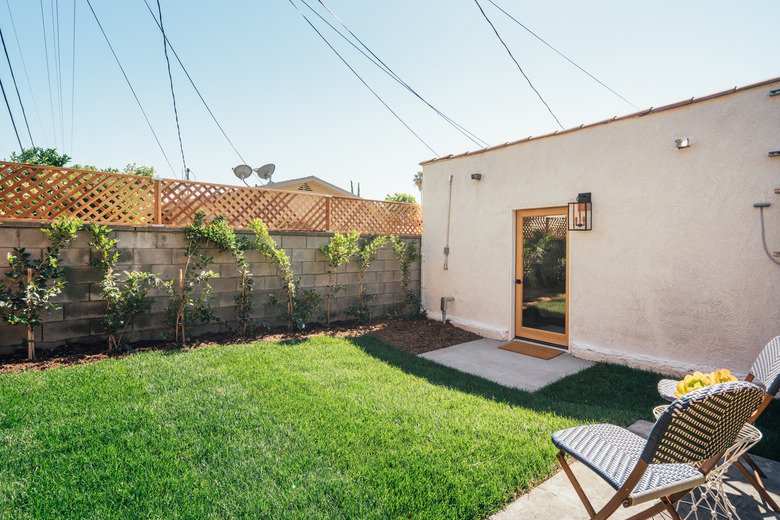How To Install A Dry Well For Yard Drainage
A dry well is essentially a hole in the yard that is filled with gravel or a special perforated liner that holds excess water and allows it to seep into the ground. It's most common use is as a repository for runoff from gutter downspouts, but landscapers also install dry wells to catch gray water from the house and to remove standing water from low-lying areas in the yard. A dry well can be useful all by itself, but it is usually incorporated in a drainage network that includes a French drain, a swale or a ditch.
Dry well systems can be great water conservation tools because they return to the water table surface water, gray water and runoff from driveways and roadways. Some communities require property owners to install one or more dry wells to improve municipal drainage, and some organizations offer incentives. For example, the Virginia Association of Soil & Water Conservation Districts, a nonprofit group, offers a reimbursement of up to 75 percent of the installation costs.
A Dry Well Requires Good Soil Percolation
Installing a dry well is a fairly uncomplicated DIY project involving little more than digging and hauling gravel. The size of the hole depends entirely on the amount of water the dry well has to hold, although if you use a liner, the hole has to be big enough to hold the liner. Landscapers often dig small dry wells with post-hole diggers and augers to improve drainage from a French drain system or to catch water from an individual downspout. Larger wells are commonly used to hold water from multiple drainage systems as well as gray water and water transferred by a sump pump from the basement or another part of the yard.
Unless you're pumping the water into it, you have to place a dry well on a low-lying part of the property to take advantage of gravity, and it will be useful only if the soil is porous enough to allow water to soak in, so a percolation (perc) test is a must. You can conduct this test yourself using the technique described by Easy Digging:
Dig a 4-foot hole on the site of the planned dry well using a post-hole digger or auger. If the hole fills with groundwater, you'll know immediately that the site is unsuitable for a dry well because the water table is too high. If the hole is dry, fill it with 5 gallons or more of water and time how long it takes for the level to fall. A rate of 1 inch every three minutes is considered very good, but if the level stays the same for several hours, the soil contains too much clay to be suitable for a dry well, so you should either find another site or consider other drainage options.
Things Needed
How to Build a Dry Well
1. Choose a Location
The best place for a dry well depends on its size and purpose, but it should never be closer to the house than 10 to 12 feet. As a rule, you should choose a well-draining location that is low enough to allow water to flow into it by gravity, but if you're digging a small dry well for a single downspout, you can place it anywhere on land that slopes away from the house as long as the soil passes the perc test.
2. Call Before You Dig
Call the national DigSafe hotline at 811 to have the underground utilities marked on your property. This prevents you from cutting into a power cable, telephone line or water pipe and creating a lot of unnecessary trouble (not to mention a safety hazard). If you have a sprinkler system, excavate around the nearest sprinkler heads to determine the direction of the pipes so you can avoid them.
3. Dig a Hole
Size the hole to guarantee that it can handle the expected flow of water. A 12-inch-diameter hole that is 3 to 4 feet deep would probably serve a single downspout, while a dry well catching water from a network of drainage pipes needs to be much bigger. Consult the chart from Harris Precast for help with sizing and keep in mind that the well should extend below the frost line if you want it to drain properly in winter. If you're installing a perforated liner, the hole has to be deep enough for a gravel bed and wide enough to backfill with gravel on all sides.
Dig the hole with a shovel, a post-hole digger or an auger depending on the diameter and depth you need. If the ground is rocky, you may need to break it up with a pick. The job may be uncomplicated, but that doesn't necessarily mean it's easy. If the dry well is part of a drainage system, this is the time to dig a trench for each drainage pipe that feeds into it.
4. Line the Hole With Landscape Fabric
Cover the sides and bottom of the hole with filter fabric to prevent effluent from flowing out of the dry well and clogging the soil. This may cause the dry well to clog eventually, but it's easier to dig it up and redo it than it is to repair clogged soil.
5. Backfill With Gravel
When digging large dry wells, landscapers typically backfill with 3/4-inch drain rock, but for small ones, pea gravel is a better choice because it can be packed more closely together. When using a liner, fill the bottom of the hole with at least 4 inches of gravel and tamp it flat and level using a hand tamper. Set the liner and connect it to the incoming drainage pipe or perforated pipe from French drains and then backfill around the outside of the liner to the top, leaving the inside empty so it can hold more water during a heavy rain.
If you aren't using a liner, backfill the entire hole with gravel. If it's a large hole, it's a good idea to backfill in stages, tamping as you go to compress the rock.
6. Cover the Hole
If you use a liner with a lid, the lid may have a pop-up overflow outlet, and this has to be above ground when you backfill with native soil. Bury everything else, including the lid itself, the gravel and the landscape fabric, with at least 2 to 3 inches of soil. If you cut away sod before digging the hole, replace it.
Dry Well Maintenance
A certain amount of clogging is inevitable with any dry well, but you can forestall this by keeping out debris. Clean your gutters regularly to keep leaves and silt out of the runoff, and if you're using a catch basin near a driveway or patio, lift the lid periodically and clean it out manually. Chesapeake Bay Foundation recommends putting a screen on all your downspout inlets, and if you do this, expect to clean them yearly to keep the eaves from overflowing or icing over.


